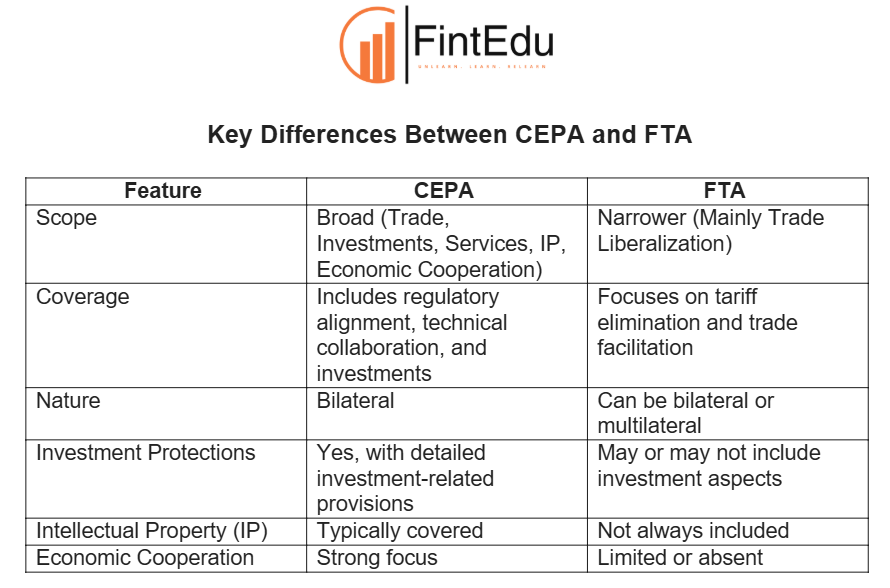LISTEN TO THIS ARTICLE
In global trade, countries establish agreements to improve economic cooperation and trade relations. Two such frameworks—Comprehensive Economic Partnership Agreements (CEPAs) and Free Trade Agreements (FTAs)—play a crucial role in international commerce. While they share similarities, they have distinct purposes and structures that set them apart.
Comprehensive Economic Partnership Agreement (CEPA)
A CEPA is a broad, bilateral economic agreement that goes beyond traditional trade deals. It includes multiple aspects of economic collaboration, such as:
Trade in Goods and Services: CEPA covers the reduction or elimination of tariffs, but it also includes services trade, making it more comprehensive.
Investment Protections: It provides safeguards for foreign investors and helps create a stable investment climate.
Intellectual Property Rights (IPR): Provisions related to patents, trademarks, and copyrights are included to strengthen cooperation in innovation and technology.
Economic and Technical Cooperation: CEPA often features collaboration in various economic sectors, encouraging knowledge exchange and capacity building.
Regulatory Frameworks: Harmonization of standards and regulations to ensure smoother business operations between the partner nations.
Since CEPAs are bilateral, they are tailored to suit the specific needs of the participating countries, allowing for deeper economic ties beyond just trade.
Free Trade Agreement (FTA)
An FTA, on the other hand, is mainly focused on trade by reducing or eliminating barriers such as:
Tariff Reductions: The main objective is to lower or remove tariffs on goods to improve market access.
Elimination of Quotas and Other Trade Barriers: FTAs work toward reducing non-tariff barriers such as import restrictions and customs duties.
Facilitation of Goods and Services Exchange: While FTAs do cover services trade, their emphasis remains on goods and tariff liberalization.
Strengthening Economic Ties: By improving trade flows, FTAs create a more competitive and resilient market environment.
Unlike CEPAs, FTAs typically focus on tariff-related trade liberalization and may not include extensive provisions on investments, intellectual property, or regulatory cooperation.

Conclusion
Both CEPAs and FTAs are important in shaping international economic relationships. However, their main difference lies in their scope while FTAs primarily target trade liberalization, CEPAs provide a broader economic partnership that includes investment, services, intellectual property, and regulatory cooperation.
For businesses and policymakers, understanding these distinctions is essential in planning market entry, investment decisions, and international trade engagements. Countries negotiating trade agreements must assess their economic goals to determine whether an FTA or a CEPA best aligns with their interests.
Disclaimer: Content posted is for informational and knowledge sharing purposes only, and is not intended to be a substitute for professional advice related to tax, finance or accounting. The view/interpretation of the publisher is based on the available Law, guidelines and information. Each reader should take due professional care before you act after reading the contents of that article/post. No warranty whatsoever is made that any of the articles are accurate and is not intended to provide, and should not be relied on for tax or accounting advice


